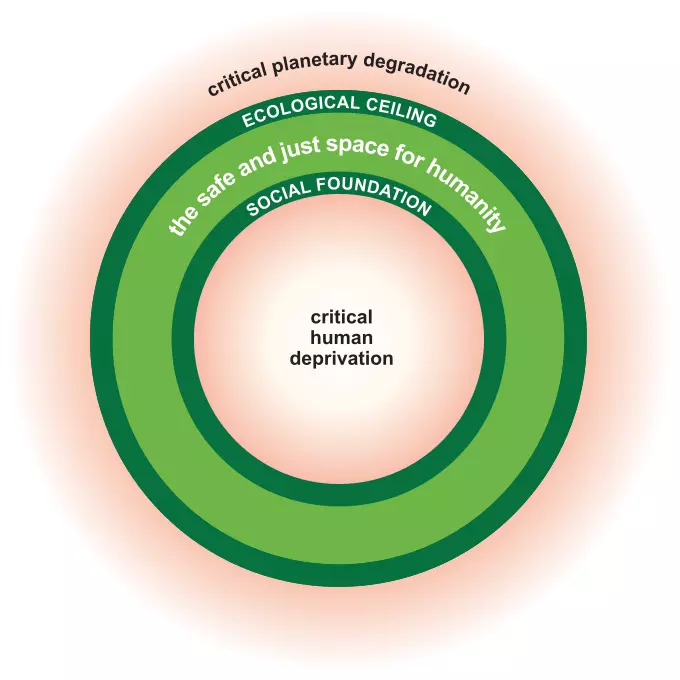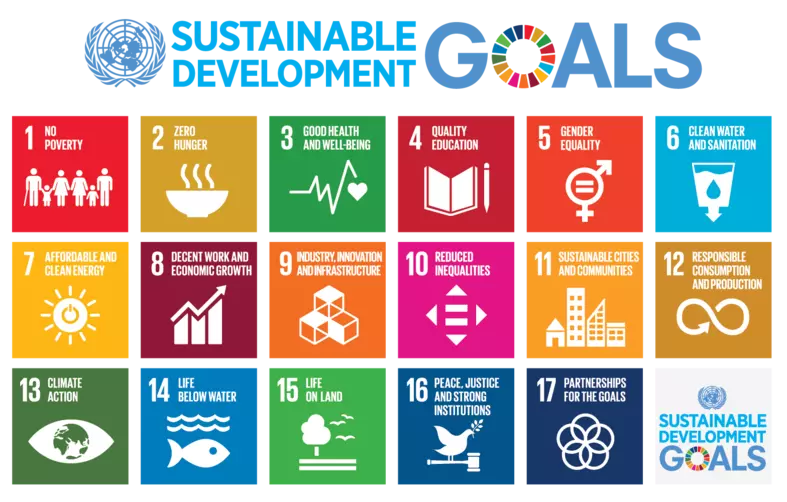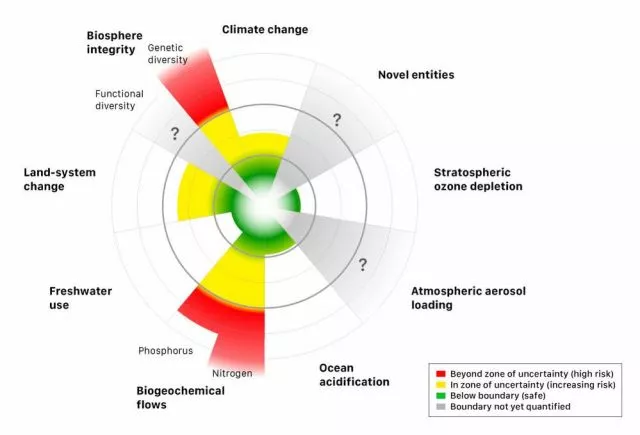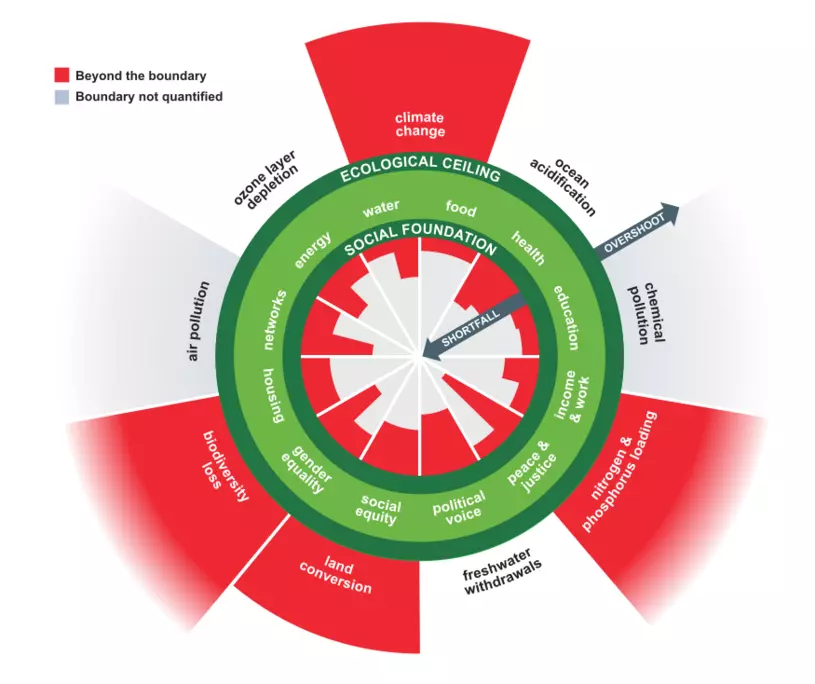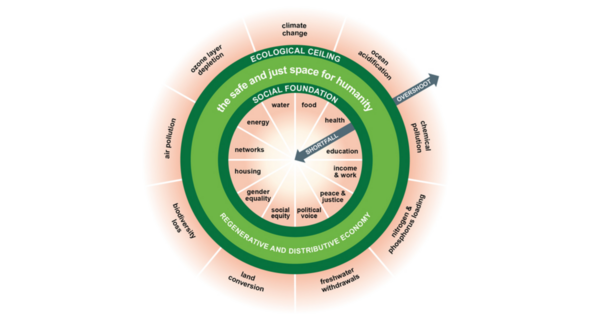
What is the Doughnut?
An introduction to the concept at the heart of Doughnut Economics

Version 1.0 (September 2020)
Overview
This tool is an introduction to the concept at the heart of Doughnut Economics. It's been designed as both a document that can be shared and a presentation that can be given in a classroom, a workshop or a meeting. Either download it as a pdf (below), open it within Google drive (links below) or scroll down to read on this page.
Links
Open as a document in Google Docs
Open as a presentation in Google Slides
What is the Doughnut?
Think of it as a compass for human prosperity in the 21st century, whose goal is to meet the needs of all people within the means of the planet.
It consists of two concentric rings:
- A social foundation – to ensure that no one is left falling short on life’s essentials.
- An ecological ceiling – to ensure that humanity does not collectively overshoot planetary boundaries.
Between these two boundaries lies a doughnut-shaped space that is both ecologically safe and socially just – a space in which humanity can thrive.
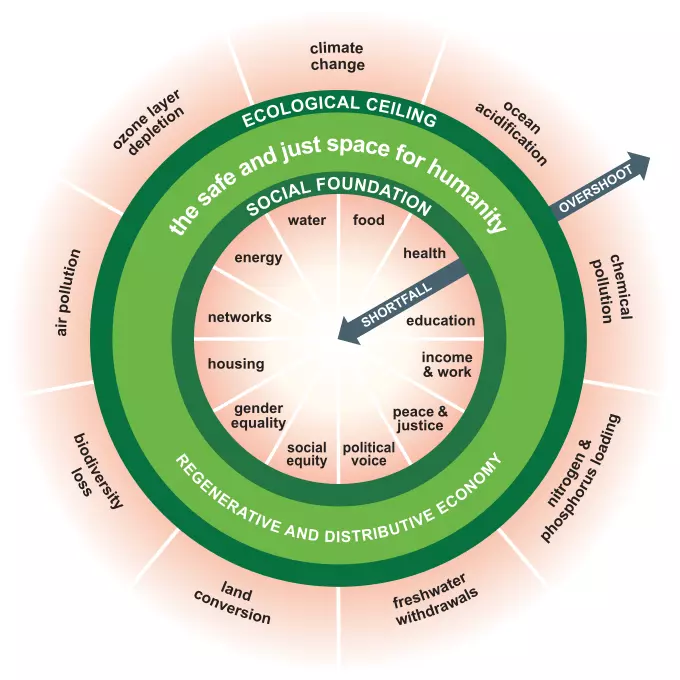
The essence of the Doughnut
1. The social foundation – below which lies critical human deprivation
2. The ecological ceiling – beyond which lies critical planetary degradation
These two boundaries are foundational in the sense that humanity should always seek to avoid critical human deprivation and critical planetary degradation. But how best to define their specific dimensions and measure their current status relative to desired outcomes will keep evolving over time.
The Doughnut’s dimensions
(as of 2017)
The Social Foundation
The 12 dimensions of the social foundation are derived from the social priorities agreed in the Sustainable Development Goals (UN, 2015).
The Ecological Ceiling
The 9 dimensions of the ecological ceiling are the nine planetary boundaries defined by Earth-system scientists (Steffen et al., 2015).
Quantifying the Doughnut
The image below reveals the current state of humanity and our planetary home: think of it as humanity’s ‘selfie’ in the early days of the 21st century.
Each dimension is measured, where possible, with 1 or 2 indicators, and the red wedges show the extent of shortfall and overshoot of the Doughnut’s social and planetary boundaries.
It shows us that millions of people still fall short on all 12 of the social dimensions, and that humanity has already overshot at least four planetary boundaries (air pollution and chemical pollution are currently unquantified).
To achieve the 21st century goal of meeting the needs of all within the means of the living planet means eliminating all of the red from the Doughnut diagram, and this must be done from both sides at the same time.
Find out more
- Explore the dimensions of the social foundation and ecological ceiling
- Explore the selection of these dimensions, including their limitations
- Read chapter one of Doughnut Economics: Seven Ways to Think Like a 21st-Century Economist
Share
Attachments
Share
-
Story

Doughnut economics on brillder
Our latest online learning module on brillder introduces students to doughnut economics
-
Story
.jpg)
Donut Brasil bursts into life!
Connecting diverse communities of practice around the idea and principles of the Donut
-
Story

Between D.E. and Gender Inclusion in Nigeria
Blending Doughnut Economics with Gender Inclusion as a solution for many challenges in Nigeria.
-
Story

Exploring sustainability in digital tech
Can Doughnut Economics be used as a holistic way of exploring the digital tech sector’s impact on global sustainability?
-
Story

Doughnut-PESTLE Hydrogen Model (DPHM)
Analysing the hydrogen economy by applying a Doughnut-PESTLE Hydrogen Model
-
Story

BORO Doughnut: DE in Middlesbrough
Bottom up practical steps taken to form a community action group and alliances to Downscale DE in a town
-
Story
.png)
Yerevan embraces “Doughnut mindset”
Reprioritizing priorities; Yerevan embraces “Doughnut mindset” on its way to sustainable development
-
Story

Renegade Neighbourhood Economists Wanted
Exploring Doughnut Economics in the round as peers.
-
Member

Auban DERREUMAUX
Dudelange, Luxembourg
-
Member


Ole Kristian Ouff
Sandnes, Norway
-
Member


Laura Zimmermann
Freiburg
I just finished my master's degree in Freiburg, studying in the M.Sc. programme Geography of Global Change. For my thesis I worked with Doughnut Economics and its practical applicability. I truly appreciate the support and treasure of knowledge of the DEAL community and platform. Now I am working at the Next Economy Lab in Bonn, realizing more Doughnut-related projects. I am drawn to the doughnut by its tangibility and immediate call for action: "Act now - theorize later!"
-
Member

Christina Köppen
Mannheim, Baden-Württemberg, Deutschland
-
Member

Angelo McNeive
Bray, Leinster, Ireland
-
Member


Keiko Okura
Glasgow, Scotland, United Kingdom
-
Member


Isabella Guerrini de Claire
Inverness, Scotland, United Kingdom
Circular Economy, Climate Leadership Strategist, Ph.D. - Wellbeing Economy Ambassador. I'm a circular economy and climate strategist and a scientist working in regenerative sustainability for the last 25 years. I’m focused in the maximisation of impact and value, through multifaceted business approaches. In my career, I worked extensively with startups, individuals, public, private and third sector corporates to rethink and redesign their economic approach with social and environmental innovation. I contributed worldwide in sustainable development and land design management within the blue economy and circular economy networks on low carbon programmes for almost twenty years, to ensure thorough business analysis and promoting sustainable solutions for social barriers, environmental challenges and innovations.
-
Member


Faris Weldy
Bogor, Jawa Barat, Indonesia
Currently studying for a bachelor's degree majoring in Resource and Environmental Economics at IPB University
